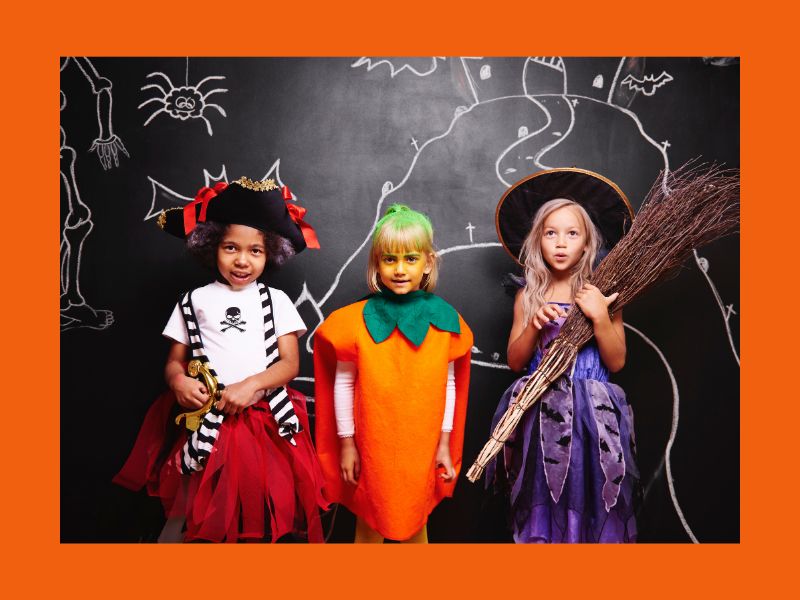By its very nature, Halloween is scary. Everything from the decorations, AMC’s listing of the top 100 horror films, the inflated price of candy, etc. But perhaps the scariest part of Halloween is trying to understand it through the eyes of our kids with autism. So how do we make this spooky night less of a nightmare?
BOO! Take out the surprise factor
Talk about Halloween ahead of time so your child will know what to expect. Show them pictures of kids in costumes, videos of kids trick-or-treating, and make sure you show your child what this will look like when it’s dark outside. Social stories can be a great preparation tool. You can even create your own social story using pictures of your kids in previous years. And don’t forget to take pictures this year for next year’s story.
Scope out the neighborhood
Take a nighttime stroll through the streets where you plan to trick-or-treat and look at the decorations. Are there any houses you might want to avoid because they look too scary? Talk to your neighbors. Is anyone planning to dress in a costume and scare the kids as they approach a house? You may also want to do an advance visit to any party or Halloween stores where you plan to take your child. I know when you walk into our local party store, you are greeted by a mechanical Jason from Friday the 13th. We all want to avoid months of sleeplessness thanks to nightmares.
You may also want to prepare your neighbors to help everyone have a better experience. Passing out this flyer ahead of time may offer some thoughtful pointers:
- Download a printable version of this flyer HERE
Teach the rules of trick-or-treating
Provide step-by-step instructions for how trick-or-treating works. For instance, how we knock on the door and say “trick-or-treat” but don’t go into the house, put the candy in the bag, say thank you, and go to the next house. Practice this routine before the big night. Some kids may need days of practice, some kids may be good with only one dry run. Don’t forget to go over what to do if there is a break in the routine, for instance if a neighbor is not home. Here’s one tricky rule. We teach our kids all year that they should never take candy from
strangers. Since our kids live by rules, they may have a difficult time reconciling this rule infraction. You may think that of course you would never go to a stranger’s house, but the stranger issue could come into play if you go trick-or-treating at a community center, mall, etc.
If your child has difficulty saying the words “trick-or-treat,” you may want to use a card such as this one:
- Download a printable version of the Trick or Treat cards HERE
Have a dress rehearsal
For a child with sensory issues, costumes can pose some problems. The costume can be itchy, too tight, too loose, too hot or not warm enough. Makeup can be sticky, or smell and feel weird. Masks can make it difficult to see or hear, or cause irritation to the head. Have your child try on their costume far enough in advance that you can make adjustments and alterations
if necessary. Easy costumes made from clothing articles you already have may be the perfect route. If your child isn’t very enthusiastic about wearing a costume, now may be an opportunity to tie in a passion and let them dress as the character they watch 800 times a month. But also let them know it’s ok not to wear a costume.
Make a candy plan
Think pre- and post trick-or-treating. If your child has a restricted diet, you could drop off packages of allowable snacks or small toys to your neighbors for them to give to your child. Or be prepared with acceptable treats you can substitute when your child gets home. If there are some candies on the approved list, ask a sibling if they would be willing to swap. Tell your child ahead of time what they can/can’t do with the candy when you get back home. Can they dump it all out and eat the entire bag that night? Will you limit your child to a certain number of candies each day? Make sure you don’t keep this plan to yourself – share it with your child so expectations are known up front.
Go with friends
Pair your child up with a neurotypical buddy that can help your child remember the trick-or-treating rules. That buddy can also be another set of eyes on your child amidst the flurry of masquerading candy goers. If your child is an eloper, it might help everyone if your child is wearing sneakers that light up, or has a glow stick or bracelet. And if you have other children, make sure you have a plan in case your child with autism wants to go home before your other children are done. If your child gets separated from the pack and is missing, call 911 IMMEDIATELY rather than wait and search yourself.
Eliminate the fear factor
There’s a lot going on during Halloween’s evening hours that startles the senses. It’s dark and there are lots of people running around in scary costumes. Go before it gets dark if your child would be afraid during the later hours or if you need a less crowded time. If going door-to-door is overwhelming for your child, offer the option to stay home and pass out candy, or invite a small group over for a candy swap. Malls and community centers might offer an alternative location, but inquire about the size of the crowds they are expecting. If your child stays home, consider the commotion. Will constant knocking at your door, or the doorbell ringing upset your child? Or the dog barking each time it rings? Or kids screaming “trick-or-treat”?
And perhaps the most important tip: make sure your plan to steal your favorite candy from your child’s bag is foolproof.
You can find more information on Pathfinders for Autism HERE




